Forget 90 Day Fiancé and the ongoing saga in Major League Baseball. The real popcorn entertainment is happening on Wall Street. Well, that is, if you are sitting on the sidelines with very little skin in the game and watching the world burn. If you are invested in the stock market, this volatility is not something you want to see happen, especially if you have a family, are nearing retirement, or have put all your eggs in one basket. What happened to the days of perpetual gains – both rapid and gradual? Are we no longer entitled to the bull market of the last 11 years?
Executives Exit Stage Left
 Executives are heading out the door, according to new data from a provider of insider trading and data analytics. The ratio of companies with insider buying compared to insider selling stood at 0.27 in July, said the Washington Service. This is the lowest level since at least the year 2000. Overall, six million shares were sold in the finance industry, while 7.4 million shares were bought. In the technology realm, 24 million shares were sold by insiders in July, while 4.2 million shares were acquired.
Executives are heading out the door, according to new data from a provider of insider trading and data analytics. The ratio of companies with insider buying compared to insider selling stood at 0.27 in July, said the Washington Service. This is the lowest level since at least the year 2000. Overall, six million shares were sold in the finance industry, while 7.4 million shares were bought. In the technology realm, 24 million shares were sold by insiders in July, while 4.2 million shares were acquired.
But what a difference a few months make. The ratio reached an 11-year high of 1.75 in March as executives took advantage of the market rout and scooped up stocks at a discount.
Insider buying and selling activity is an important metric for investors. It indicates if corporate insiders think the company has sufficient liquidity to endure a massive decline in economic activity and enough solvency to face an economy that might not be as strong as it was in the past.
So, who were the big sellers in July? CNBC compiled a list using data from the Securities and Exchange Commission (SEC) filings:
- BlackRock’s Larry Ink sold more than 40,000 shares ($24 million).
- UnitedHealth Chair Stephen Hemsley ditched close to 230,000 shares ($70 million).
- B. Hunt Transport Chair James Thompson unloaded 15,000 shares ($2 million).
- Morgan Stanley CEO James Gorman got rid of 150,000 shares ($8 million).
Still, financial services firm Raymond James noted that many sectors are still seeing greater insider buying, particularly in the financials. Of the businesses covered by the investment banking firm, those in the financial sector are witnessing about 16% of insiders picking up stock.
Time for Another Blood Bath?
What does this mean for the average investor? Should we buy another crate of Pepto Bismol and perhaps a lifetime supply of razor blades? It would be rather fitting for 2020 if the stock market hit a record high, experiences a massive collapse, records a stellar rebound, trades relatively flat, and then craters again. This would be a roller coaster ride that not even Six Flags could emulate – its stock has regained about 10% since April, by the way.
It is unlikely that the U.S. stock market will experience another crash comparable to what happened earlier this year. The Federal Reserve has pumped trillions of liquidity into the equities arena, and Fed Chair Jerome Powell has repeatedly signaled that the central bank has Wall Street’s back. In the weeks leading up to the financial crisis, the Fed dismissed the idea of intervening. Plus, a lot has changed since then: unlimited quantitative easing, corporate bond-buying, and near-zero interest rates. The Fed could pull out a few tricks, such as subzero rates and stock purchasing, but it would not be necessary.
The Fed and even the Congress stopped the hemorrhaging with some stitching and bandages. It is only a matter of time before financial markets become hemophiliacs again. But with printing presses working overtime and cheap money in perpetuity, the New York Stock Exchange is unlikely to have more Black Mondays anytime soon – that comes later.
The Inflation Bomb
The real problem that Americans will contend with is the ticking post-Coronavirus inflation bomb. The Fed has injected trillions of dollars into the market in a short period, and it will continue to monetize the debt after the government approves the next round of stimulus. As this freshly printed money flows into the real economy, the U.S. dollar is depreciated, and price inflation pops. This explains the massive rally in gold and silver prices as of late – U.S.-China tensions, a weaker greenback, and global economic uncertainty are also contributing factors to the yellow metal hitting an all-time high. A second stock market crash would be devastating, but exploding price inflation would be a lot worse for every low-income and middle-class American.
~
Read more from Andrew Moran.



